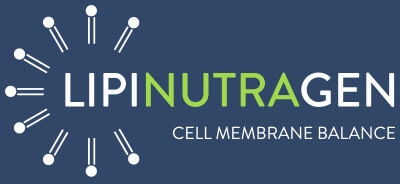
The essentiality of polyunsaturated fatty acids


The membrane, the cells’ gateway!
The human body is made up of billions of cells, all surrounded by a vital coating: the cell membrane. It is a complex mixture of fats in a fluid state, where proteins and another fat, well known to the public, cholesterol, are immersed.
The cellular or plasma membrane constitutes for the cell a coating that surrounds it but not an “isolation”, indeed it is the way of communication between cell and external, collecting and sending signals between the other cells of the same tissue and of different tissues distanced one from another, as well as the way of passage and exchange of nutrients necessary for the life of the cell itself.
The basic constituents that create the membrane structure are phospholipids, molecules composed of fatty acids with different chemical structures. Each organ, therefore each tissue, of our organism has the membrane that contains a composition of fatty acids, equal in type but different in quantity from fabric to fabric, creating a real identity card, which allows recognition but which above all allows the adequate functionality of that organ. (1)
Although very briefly, what has been mentioned on the cell membrane shows how this compartment is fundamental for the life of every human being and how its composition is information to be acquired and deepened regarding the correct distribution of the various types of fatty acids.
Chemical “bonds” make the difference
Fatty acids, based on their chemical structure, are divided into two large families: saturated and unsaturated. Saturated fats have a linear structure and participate in the construction of the cell membrane giving it stability and rigidity; unsaturated fats have a more flexible structure, with one or more folds (called unsaturation) which results in the construction of a more fluid and permeable membrane. Due to the presence of both types, the membrane is in fact an alternation of more rigid and more fluid areas, each with its role in the overall functioning of the cell. Based on the number of folds, unsaturated fats are divided into monounsaturated (a single fold) and polyunsaturated (multiple folds). (2)
In addition to being present in the diet, saturated and monounsaturated fatty acids are constantly produced by our body through specific “metabolic machines”, called enzymes. As for the production of polyunsaturated fatty acids, it starts from precursors that the human body cannot build independently, since it does not have the necessary enzymes. This determines the absolute need to introduce polyunsaturated precursors from the diet, which are called essential fatty acids. Subsequently, the entire series of omega-6 and omega-3 polyunsaturated fats will be formed from the precursors. The composition of the cell membrane is obtained, therefore, both from the work of our body’s “metabolic machines” and from fats, which should be mainly polyunsaturated, which we introduce with food every day. (2)
We are the architects of the correct composition of the membrane, choosing what we bring to the table every day!
The well-being essential balance
 The composition of the cell membrane reflects the food lifestyle and the body’s metabolism. It is necessary to pay particular attention to the choice of fats and keep in mind the indispensable role that Omega-6 and Omega-3 polyunsaturated fatty acids play as structural and functional elements of the cell.
The composition of the cell membrane reflects the food lifestyle and the body’s metabolism. It is necessary to pay particular attention to the choice of fats and keep in mind the indispensable role that Omega-6 and Omega-3 polyunsaturated fatty acids play as structural and functional elements of the cell.
Polyunsaturated fatty acids or PUFA are of two types: Omega-6 and Omega-3.
PUFA Omega-6: this family has the negative reputation of being “pro-inflammatory”, because among its components there is Arachidonic Acid, protagonist of the inflammatory reactivity of our body. This negative meaning is incorrect if we consider that inflammation is not actually a harmful process, but it is the response of our body that “must solve a problem”; the problem arises when the inflammatory process, which is triggered in the cell to defend it, cannot turn off properly. Another point that does not justify the bad reputation of omega-6 PUFAs is represented by the activity carried out by some of its components, including DGLA, a very important omega-6 fatty acid implicated in anti-inflammatory and immune processes. For further information >> https://www.lipinutragen.it/en/dgla-at-the-crossroads-of-pro-and-anti-inflammatory-processes/
PUFA Omega-3: its best known components are EPA and DHA, long chain omega-3 fatty acids, which participate in the fluidity of the membrane and are important constituents of the cell membrane of the nervous system and the retina, especially DHA. EPA is a precursor of molecules with different activities, the most important being the anti-inflammatory one which balances the reactivity implemented by Arachidonic Acid, and together with DHA they promote the resolution of inflammatory processes in all tissues. For further information >> https://www.lipinutragen.it/en/omega-3-dha/
The Omega-6 and Omega-3 tracks, in addition to having essentiality in common, share the “enzymatic machines” which provide for the metabolic transformations of the various components of the families; the contribution from the diet must be balanced, without excess of one or the other family, to ensure the cell membrane the structural and functional balance that it needs. (2)
Food choices (including supplements) as needed
From this brief examination it is clear the need to know the composition of our cell membrane, to find out if there are deficiencies or imbalances, and to target the food choice in order to ensure balance. Being aware of your molecular state and taking care of it is simple, and it is lipidomics that can give us the answer in a personalized way: the ideal tool represented by the Lipidomics Analysis of the red cell membrane allows you to understand how the cells of our tissues are forming their own membrane in consequence to daily choices, nutrition and metabolism.
After the result of the analysis, there is the possibility to find out the diet and possibly the necessary integration to the identified needs, therefore to implement a personalized strategy, coined by us with the term NUTRILIPIDOMICA.
Read more about the cell membrane lipidomic analysis >> https://www.lipinutragen.it/en/importance-of-lipidomics/
Bibliography:
- Harayama et Riezman. Understanding the Diversity of Membrane Lipid Composition. Nat. Rev Mol. Cell Biol. 2018, 19, 281-296
- Cell membrane and lipidomics. Carla Ferreri and Chryssostomos Chatgilialoglu. 2014, CNR Editions
Article edited by the Lipinutragen Editorial Board
The food recommendations in the article are not intended to replace a personalized food plan and are to be adapted to specific cases.
Photo: @Oleksandra Naumenko
- On 11 June 2020



